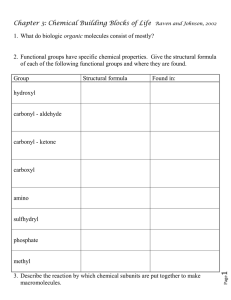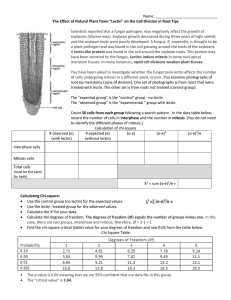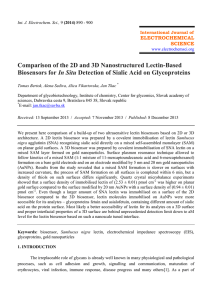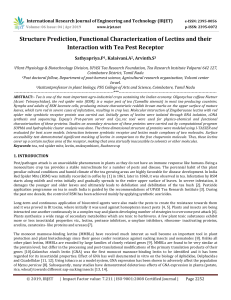From lectin structure to functional glycomics: principles of the sugar code Alexander Hsieh
advertisement
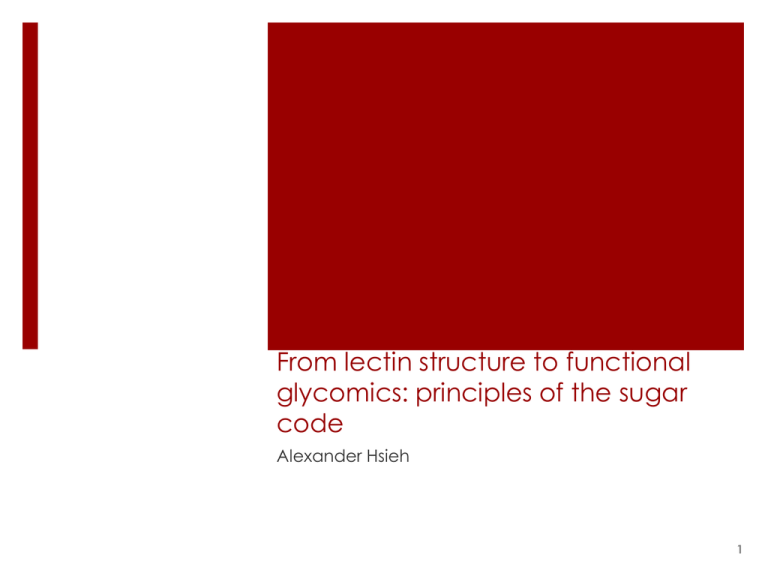
From lectin structure to functional glycomics: principles of the sugar code Alexander Hsieh 1 2 Intro Lectins: carbohydrate-binding proteins which lack enzymatic activity on their ligand; are distinct from antibodies and free mono- and oligosaccharide sensor/transport proteins. Sugar-binding capacity determined by dozens of folds and wide range of binding site architecture Question: How do we explain target specificity of endogenous lectins for certain cellular glycans? 3 Glycosylation: Abundant and Frequent Factors influencing protein functionality: Post-translational modification Glycan chain branching and length Ex: glycocalyx: the sugar coating that protects cells in eukaryotes and bacteria; acts as filtration/selective-binding device, key for recognition Conjugation of sugars to proteins known total of 13 monosaccharides + 8 amino acids = at least 41 types of glycosidic linkages Variety allows for glycan bioactive signaling ability Hold information coding exclusive to proteins 4 N-glycosylation Typical entry point = Asn – X – Ser/Thr X = any amino acid except proline Common in proteins from the extracellular side of the membrane and those on the route trafficking from the ER to cell membrane/lysosomes Assume loop, turn or β-sheets 5 N-glycosylation cont’d N-glycans are complex (100+ structures) and have highly sophisticated enzymatic machinery Implies more than just passive effect (ex: solubility) of protein glycosylation Suggest a coding system for carbohydrates (aka “Sugar Code”) Coding capacity ideal for generating compact units with explicit informational properties 6 Carbohydrates: the sweet side of biorecognition Much more diversely coded structures (1.44x10^15) than oligonucleotides (4096) or peptides (6.4x10^6) Factors contributing to structural diversity: 2 anomeric configurations (α,β) Bonding at different linkage positions (1->1, 2, 3, 4, 6) Change in ring size (pyranose/furanose) Branching Site-specific substitutions (acetylation, phosphorylation, sulfation) 7 Carbohydrates cont’d Hydroxyl groups suited as donors/acceptors in Hbonding C-H bonds suited for van der Waals interaction and stacking because of inherent polarization Epimerization – main carbohydrate constituents differ only in relative position of 1 or 2 hydroxyl OH group location + coordinated hydrophobic patches create characteristic profile of potential contact (as recognized by amino acid side chains) 8 Calcium as a factor Ca2+ ion = natural alternative for amino acid side chains to sense spatial distribution of OH groups Strategic Role of Ca2+ in Lectin Activity: Stabilizes lectin domain and organizes site for ligans binding Oligomerizes subunits Facilitates direct contact to neutral and anionic groups of ligans Neutralizes repulsive forces between the anionic charge on the ligand and lectin


